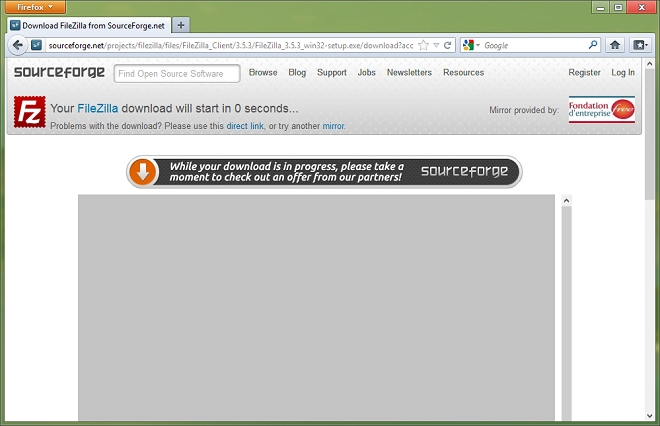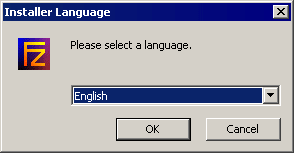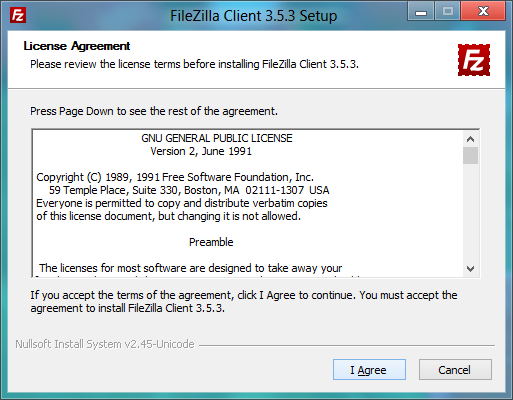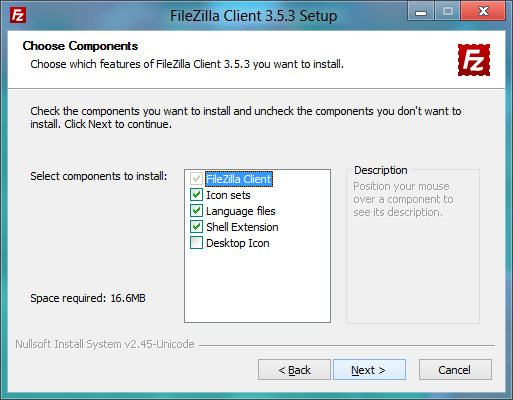Client Installation: Difference between revisions
| Line 124: | Line 124: | ||
You can find [[Client_Compile|compiling instructions]] on this wiki. The page is outdated and incomplete but it'll give you a general idea. You will have to check out the different forums ([http://filezilla.sourceforge.net/forum/ Main forum] or [http://sourceforge.net/forum/?group_id=21558 sf.net forums]) to get more information. | You can find [[Client_Compile|compiling instructions]] on this wiki. The page is outdated and incomplete but it'll give you a general idea. You will have to check out the different forums ([http://filezilla.sourceforge.net/forum/ Main forum] or [http://sourceforge.net/forum/?group_id=21558 sf.net forums]) to get more information. | ||
===Upgrading from FileZilla 2 to 3=== | ===Upgrading from FileZilla 2 to 3=== | ||
You can load the saved connection/configuration data from your version 2 installation via the | You can load the saved connection/configuration data from your version 2 installation via the Edit/Import command. The configuration data should be in a file named ''filezilla.xml'' in the version 2 directory. | ||
You will receive a warning message about the file format having changed, but it appears to work perfectly anyway. | You will receive a warning message about the file format having changed, but it appears to work perfectly anyway. | ||
Revision as of 02:51, 22 September 2007
|
This documentation attempts to explain installation of the FileZilla (S)FTP Client for Microsoft Windows. FileZilla comes in three versions. There is an installer version that offer ease of installation and uninstallation for novice users, a zipped version for people that don't like installers or have special needs, and then for the advanced user there is a source version which lets you take a look at, modify and/or compile the source code of FileZilla. Don't worry if you find this confusing, I'll get back to each of them in depth later in this document and try to help you choose which one you need. GettingIMPORTANT NOTE: It is _strongly_ recommended that you only download FileZilla from the official source to avoid viruses and spy ware. There have been unofficial versions of FileZilla that contained viruses and spy ware on sites like download.com, so don't use them! Also, I recommended to always get the latest version of FileZilla regardless of which version this documentation or the download page was based on! Choosing the right downloadAs I said earlier, there are three different FileZilla versions you can download. Basically they are all the same, they are just presented to you differently. I will now try to explain each of them before we start downloading FileZilla in the next section. Installer versionAs a novice user the installer version is the safe and easy choice. With this version you only need to download the file, run it and the program will get installed by itself. The installer version also comes with so called debug files which helps solve problems should a program crash occur. If you don't know which version to get, this is probably the one you want. However, if you don't have sufficient rights to install programs on the computer you are using (e.g. at work or at school) the zip version is the way to go. If you've already decided to go for the installer version, you can go directly to downloading. Zip versionIf you have special needs, don't have sufficient rights to install programs or don't like installers, the zip version is there for you. A zip-file is a file that contains files inside of it. They are packed into one file and you need to unpack (unzip) them to use them. To do this you need a zip program (or if you are running Windows XP there's a simple unzipper included in the operating system). If you need such a program I can recommend the free and open source based program 7-zip. TIP: If you want to put FileZilla on a USB stick so you can bring your copy of FileZilla with all its settings wherever you go, the zip version is the best bet. Source code versionThis is for the advanced user who wants to take a look at or modify the source code of FileZilla. You can find compiling instructions on this wiki. The page is outdated and incomplete but it'll give you a general idea. You will have to check out the different forums (Main forum or sf.net forums) to get more information. Downloading FileZillaBy now you should have made up your mind on which version you want to download. If not, go back to choosing the right download and make a decision. Choosing the appropriate versionNow it's time to head over to the download section. Click this link (if you right-click it and choose Open in New Tab you can still follow this guide while downloading) and then wait for the page to load. Still remember which version you want to get? You now need to download the correct file, the download page will help you with this. Choose between installer, zip or source code version. Next, click the link you want. Download location (outdated, Sourceforge has changed their site)You will not get to a new page which should look something like the picture below(if it doesn't and looks like the next picture that's ok too, it just means you have already selected a place to download FileZilla from and can skip this step): Click on one of the locations closes to you. E.g. if you live in South America, go for the one from Brazil (you need to click the "download" link icon under the Download column, and not the logo under the Host column). Getting the file (outdated, Sourceforge has changed their site)After you've done that this page will appear (will differ slightly if you've selected another location than I did): After some seconds a window should pop up telling you that you are trying to download a file. If it doesn't, try clicking the link manually. If that doesn't work either, go back and try another location, the host may be down. Saving and runningDepending on which browser you are using you will (normally) see a window where you can decide what to do with the file you are downloading. The easiest way is just to hit run or open and the file will download and then be run. You might get some warning messages telling you that you are running a potentially dangerous file downloaded from the Internet, but let me assure you, Sourceforge is a reliable download source and it shouldn't be any problem.. If you are familiar with how to save the file and would like to do that, go ahead. Just remember to save it where you can easily find it afterwards and then open it from there :) Hopefully after the file downloads you will have started the FileZilla installer if you went for the installer version or opened the zip file in a zip program for any other version. In the next section I'll help you through the installation process. InstallingWith installer versionMake sure that the user account which is being used for the installation has administrative rights that allow the installation of software. Installer languageA screen will be displayed where you can choose the Installer Language, select the language you require from the list. Then click on OK to continue. License agreementHopefully you should now see the following window where you will have to accept the terms of the license agreement to continue. Read through it and click "I Agree" if you do. Choosing componentsNext you need to choose which parts of the FileZilla client you want to install. If you hover your mouse over a choice, FileZilla will show you a description of the item. Here is the window: Go through all of them and just check/uncheck the stuff you want. I would recommend getting the English or French documentation, additional languages if you want FileZilla in another language than English, Start Menu Shortcuts and Desktop icons for easy access to the program after it's installed and then finally debug files which like I said can help fix problems with program bugs/crashes. So I basically recommend going for the "Standard" type of install, installing everything except the source code which is just for the advanced user who knows if he wants it or not :) When you're all finished, click Next. Install locationThe next window will ask you where to install the program. If you don't have any special needs, click Next. TIP: If you want to put your FileZilla installation on a usb stick or some other kind of portable storage, you can specify to install FZ to that location here. But you need to use the xml file for storing FileZilla's settings so that they also get transferred when you use the usb stick on another computer. You can specify this later in the installation process.. Regardless if you chose to install the start menu shortcuts or not, you will be asked what you want to name the folder with the shortcuts to FileZilla inside. The default name "FileZilla" should be good for most people. You can also choose not to install these shortcuts (again you say? yes, again! :p). General settingsAfter you've clicked Next you will come to the general settings window. These settings can't be changed without reinstalling FileZilla so you should decide now what you need. Read the text explaining the options thoroughly and decide what you want. Personally I use non-secure mode since I'm the only person using my computer and the xml file for storing settings because it's easier to backup/restore and I feel it keeps me more in control. Also, if you're going for an USB stick installation, you want to go for the xml file. Finishing installationWhen you click Next, FileZilla will get installed. If no errors occur it should complete in some seconds. When it's done, click Close to finish the installation. Congratulations, you've now successfully installed the FileZilla Client and can now move on to running! With zip versionInstallation with the zip version is very simple as long as you know how to work with zip files and can manage general file and directory handling in Windows. Basically you just extract (unzip) the downloaded file to a folder on your disk, e.g. "C:\Program Files\FileZilla\" and then just start FileZilla with the filezilla.exe file afterwards. It might be a good idea to make a shortcut to this file on your desktop/start menu/quick launch so that you can easily access it. Installing FileZilla on a USB stick or any other portable storage is just a matter of extracting/copying the FileZilla folder to that location, as the zip version of FileZilla always use the xml file for storing its settings. Using source codeYou can find compiling instructions on this wiki. The page is outdated and incomplete but it'll give you a general idea. You will have to check out the different forums (Main forum or sf.net forums) to get more information. Upgrading from FileZilla 2 to 3You can load the saved connection/configuration data from your version 2 installation via the Edit/Import command. The configuration data should be in a file named filezilla.xml in the version 2 directory. You will receive a warning message about the file format having changed, but it appears to work perfectly anyway. RunningFileZilla is simply run by double-clicking the filezilla.exe file (default location: "C:\Program Files\FileZilla\filezilla.exe") or one of the shortcuts on the desktop or in the start menu that you may have created during the installation of FileZilla. There are command line arguments you can use. |
FileZilla Client Documentation Contents |



